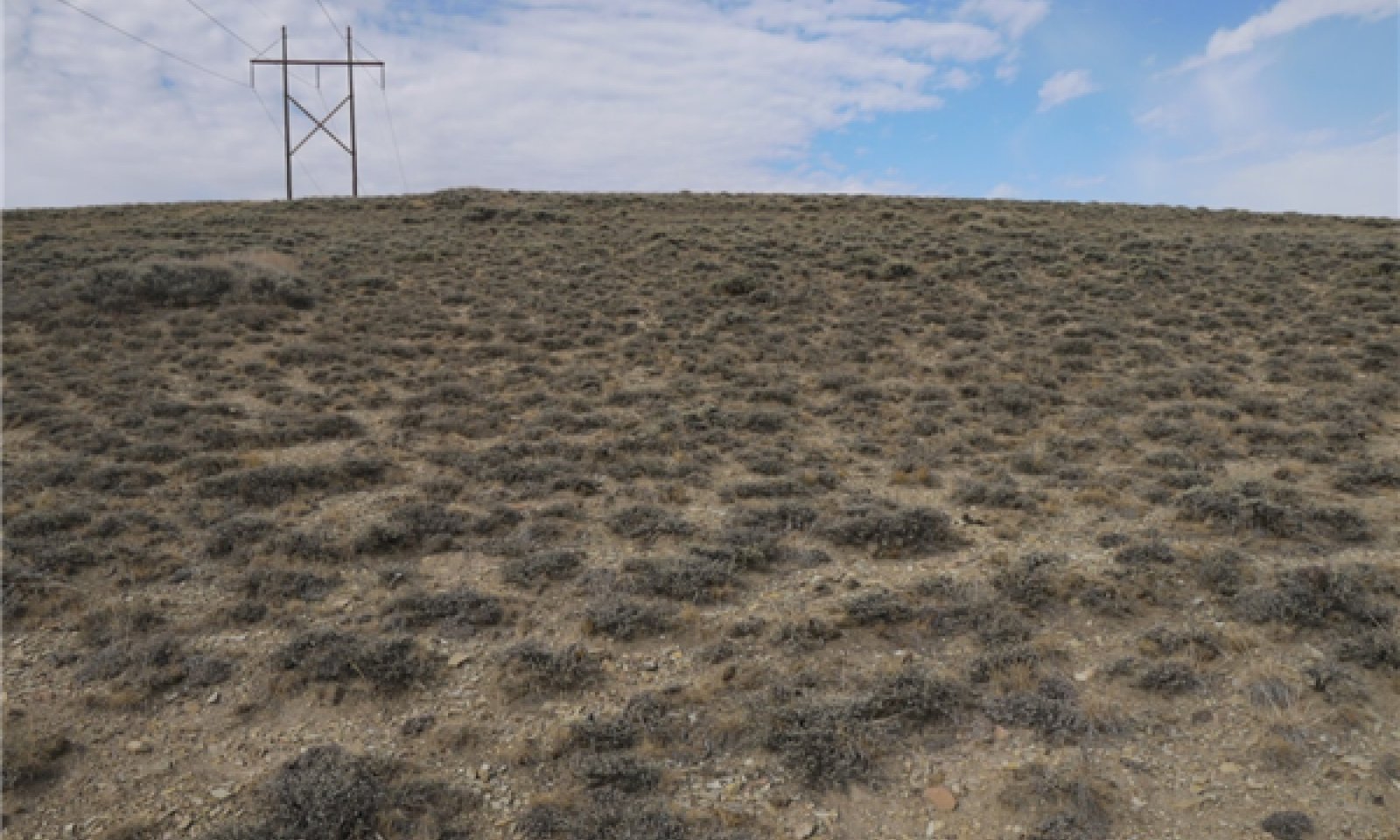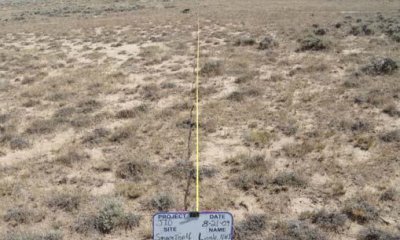
Loamy Argillic Pinedale Plateau (LyA PP)
Scenario model
Current ecosystem state
Select a state
Management practices/drivers
Select a transition or restoration pathway
- Transition T1A More details
- Transition T1B More details
- Restoration pathway R2A More details
- Transition T2A More details
- Restoration pathway R3A More details
-
No transition or restoration pathway between the selected states has been described
Target ecosystem state
Select a state
Description
The Reference State consists of two communities: the Early Sagebrush/Bunchgrass Community (1.1), and the Bunchgrass/Early Sagebrush Community (1.2). Each community differs in percent composition of bunchgrasses and percent woody canopy cover. Forbs are a minor component on this site. Woody canopy cover is typically less than 30 percent.
Dominant shrub species is Early Sagebrush in the Reference State (1), with some instances of rabbitbrush, Wyoming big sagebrush, and salt desert shrubs.
Two important processes occurring in this state drive plant communities away from the Early Sagebrush/Bunchgrass Community (1.1): improper grazing management both wildlife and domestic.
Improper grazing management without adequate growing-season deferment decreases the vigor of plants that are heavily grazed and not highly grazing tolerant. Muttongrass, indian ricegrass and letterman’s needlegrass decreases in vigor and species composition. Through natural succession and proper management this plant community will increase in bunchgrass composition and drive the Early Sagebrush/Bunchgrass Community (1.1) to the Bunchgrass/Early Sagebrush Community (1.2). If improperly managed the species composition of muttongrass, inidan ricegrass and letterman’s needlegrass will decline and sagebrush canopy will begin to increase. Once the amount and vigor of bunchgrasses declines to the point where there is limited seed source to repopulate the stand and is replaced by higher sagebrush canopy cover, the site transitions to the Grazing Resistant State (2).
The increase in woody canopy cover can occur with or without degradation of the understory. Therefore, the transition to the Grazing Resistant State (2) can occur from the Bunchgrass/Early Sagebrush (1.2) Community within the Reference State (1). The shift from the Early Sagebrush/Bunchgrass Community (1.1) to the Bunchgrass/Early Sagebrush Community (1.2) is dependent on an increase of herbaceous canopy cover, and on the decrease of woody canopy cover.
The shift from the Early Sagebrush/Bunchgrass Community (1.1) or the Bunchgrass/Early Sagebrush Community (1.2) is dependent on an increase of herbaceous cover. Without proper grazing management both wild and domestic, shrubs will increase on this ecological site
Submodel
Description
The Grazing Resistant State (2) is characterized by an herbaceous layer dominated by bluegrasses, rhizomatous grasses, and a varying shrub component. Muttongrass, indian ricegrass and letterman’s needlegrass have become scarce or absent. This state has one plant community, Early Sagebrush/Rhizomatous Wheatgrass-Sandberg Bluegrass-Mat Forb Plant Community (2.1).
The site crosses the threshold to the Grazing Resistant State (2) from the Reference State (1) when desirable mid-stature grasses lose dominance. Once the key species become scarce, it is unlikely that they have sufficient reproductive capability (seed source, tillering, or resprouting) to recover dominance in a reasonable time frame without extra energy being added to the system.
The Plant Community in the Grazing Resistant State (2) is very resilient and therefore common on Loamy, Argillic sites in this MLRA. In many cases, the transition to the Grazing Resistant State (2) may have occurred many decades ago during the era of high stocking rates and continuous grazing. While dominance by rhizomatous grasses makes the return to the Reference State (1) plant community difficult, it also makes the site resistant to further degradation. The main factor creating high resiliency of the Early Sagebrush/Rhizomatous Wheatgrass-Sandberg Bluegrass-Mat Forb Plant Community (2.1) is that the bluegrass and rhizomatous grasses are highly grazing tolerant. The bluegrass and rhizomatous grasses are low to the ground, so, even under heavy grazing, enough biomass remains for the grasses to maintain plant vigor. The rhizomatous grasses can form mats that provide soil protection by protecting the soil from raindrop impact, decreasing the risk of soil erosion. However, overall soil health is lower than the reference state, primarily due to a reduction in soil organic matter. Reduced soil organic matter is due to a reduction in litter. The decreased infiltration is due to shallower rooting depths and increased runoff. Under continuous high intensity early season grazing, especially by horses, does ground cover decrease to a point that the site will transition to the Eroded State (3).
Submodel
Mechanism
The driver for Transition T1-2 is continuous spring grazing and/or long-term drought.
Continuous spring grazing (wild and domestic) and/or drought can lead to a decline in palatable bunchgrasses. As bunchgrasses diminish or die during periods of stress, bluegrasses and rhizomatous grasses gain a competitive advantage, creating a shift in species composition towards less productive, shorter species.
Once mid-stature bunchgrass species become scarce, it is unlikely that they have sufficient reproductive capability (seed source, tillering, or resprouting) to recover dominance in a reasonable time frame without extra energy being added to the system. When the understory plant community has been degraded to this point, the transition to the Grazing Resistant State (2) can occur from either the Bunchgrass/Early Sagebrush Community (1.2). The transition is not dependent on the increase of woody canopy cover, but rather on the decrease of bunchgrasses becoming scarce in species composition.
Management should focus on grazing management strategies that will prevent further degradation. This can be achieved through a grazing management scheme that varies the season of use to provide periodic deferment during the critical growth period (roughly May-June). Forage quantity and/or quality in the Grazing Resistant State (2) may be substantially reduced compared to the Reference State.
Rangeland Health Implications/Indicators: The Biotic Integrity is impaired through the shift in relative dominance of functional/structural groups as well as a decrease in the number of species within a functional/structural group as well as reduced site productivity. The changes in bare ground patterns affect both Soil Site Stability and Hydrologic Function.
Mechanism
The driver for Transition T1-3 is continuous high intensity early season grazing and/or long-term drought.
The Reference State (1) transitions to the Eroded State (3) if plant canopy cover declines significantly or total annual aboveground biomass production falls. The trigger for this transition is the loss of bunchgrasses, which creates open spots with bare soil. Soil erosion is accompanied by decreased soil fertility driving the transitions to the Eroded State. Several other key factors signal the approach of transition T1B: an increase in soil physical crusting, a decrease in soil surface aggregate stability, and/or evidence of erosion, including water flow patterns, development of plant pedestals, and litter movement.
Mechanism
The drivers for this restoration pathway are removal of woody species and restoration of native herbaceous species by mechanical or chemical treatment of sagebrush, and grazing rest or deferment. If some mid- stature bunchgrasses remain under the sage canopy, proper grazing management can move the site back to the Reference State (1) combined with a mechanical or chemical sagebrush treatment. This could take multiple generations of management or could be accelerated with rest or deferment combined with successive wet springs conducive to seed germination and seedling establishment. (Derner, Schuman, Follett, & Vance, 2014)
Mechanism
The driver for this transition is continuous high intensity early season grazing.
Removal of shrubs without proper grazing management can lead to an increase in bare ground and erosion of the upper soil horizon, and the site can degrade to the Eroded State (3). Consequences of this transition are decreased soil fertility or even soil erosion, soil crusting, and decrease of soil surface aggregate stability.
Model keys
Briefcase
Add ecological sites and Major Land Resource Areas to your briefcase by clicking on the briefcase (![]() ) icon wherever it occurs. Drag and drop items to reorder. Cookies are used to store briefcase items between browsing sessions. Because of this, the number of items that can be added to your briefcase is limited, and briefcase items added on one device and browser cannot be accessed from another device or browser. Users who do not wish to place cookies on their devices should not use the briefcase tool. Briefcase cookies serve no other purpose than described here and are deleted whenever browsing history is cleared.
) icon wherever it occurs. Drag and drop items to reorder. Cookies are used to store briefcase items between browsing sessions. Because of this, the number of items that can be added to your briefcase is limited, and briefcase items added on one device and browser cannot be accessed from another device or browser. Users who do not wish to place cookies on their devices should not use the briefcase tool. Briefcase cookies serve no other purpose than described here and are deleted whenever browsing history is cleared.
Ecological sites
Major Land Resource Areas
The Ecosystem Dynamics Interpretive Tool is an information system framework developed by the USDA-ARS Jornada Experimental Range, USDA Natural Resources Conservation Service, and New Mexico State University.




